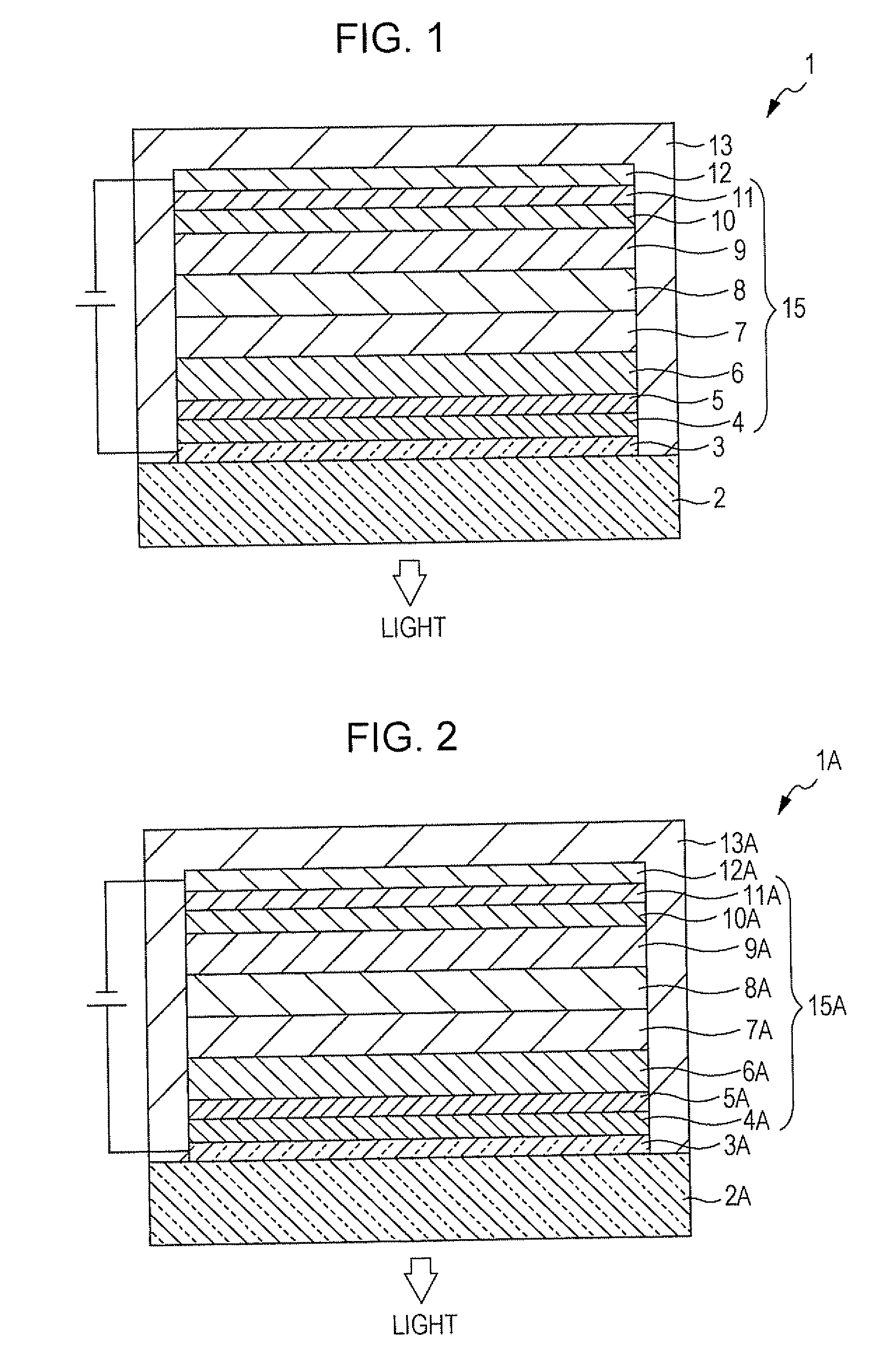Light-emitting device, display apparatus, and electronic system
- Summary
- Abstract
- Description
- Claims
- Application Information
AI Technical Summary
Benefits of technology
Problems solved by technology
Method used
Image
Examples
first embodiment
[0075]FIG. 1 is a schematic diagram showing the longitudinal section of a light-emitting device according to a first embodiment of the invention. For illustration purposes, the top of FIG. 1 is referred to as “top”, whereas the bottom of FIG. 1 is referred to as “bottom”.
[0076]A light-emitting device (EL device) 1 shown in FIG. 1 emits red (R) light, green (G) light, and blue (B) light to provide white light.
[0077]The light-emitting device 1 is formed by stacking an anode 3, a hole-injecting layer 4, a hole-transporting layer 5, a red light-emitting layer (first light-emitting layer) 6, an intermediate layer 7, a blue light-emitting layer (second light-emitting layer) 8, a green light-emitting layer (third light-emitting layer) 9, an electron-transporting layer 10, an electron-injecting layer 11, and a cathode 12 in the above order.
[0078]In other words, the light-emitting device 1 includes a laminate 15 formed between the two electrodes (the anode 3 and the cathode 12) by stacking t...
second embodiment
[0185]FIG. 2 is a schematic diagram showing the longitudinal section of a light-emitting device according to a second embodiment of the invention. For illustration purposes, the top of FIG. 2 is referred to as “top”, whereas the bottom of FIG. 2 is referred to as “bottom”.
[0186]A light-emitting device (EL device) 1A shown in FIG. 2 emits red (R) light, green (G) light, and blue (B) light to provide white light.
[0187]The light-emitting device 1A is formed by stacking an anode 3A, a hole-injecting layer 4A, a hole-transporting layer 5A, a red light-emitting layer (first light-emitting layer) 6A, an intermediate layer 7A, a blue light-emitting layer (second light-emitting layer) BA, a green light-emitting layer (third light-emitting layer) 9A, an electron-transporting layer 10A, an electron-injecting layer 11A, and a cathode 12A in the above order.
[0188]In other words, the light-emitting device 1A includes a laminate 15A formed between the two electrodes (the anode 3A and the cathode 1...
example 1
[0363](1) First, a transparent glass substrate with an average thickness of 0.5 mm was prepared. Next, an ITO electrode (anode) with an average thickness of 50 nm was formed on the substrate by sputtering.
[0364]The substrate was subjected to ultrasonic cleaning in acetone and then in 2-propanol and was subjected to oxygen plasma treatment.
[0365](2) Next, a hole-injecting layer with an average thickness of 30 nm was formed on the ITO electrode by depositing LG101 (manufactured by LG Chem, Ltd.) through vacuum deposition.
[0366](3) Next, a hole-transporting layer with an average thickness of 20 nm was formed on the hole-injecting layer by depositing N,N′-bis(1-naphthyl)-N,N′-diphenyl-1,1′-biphenyl-4,4′-diamine (α-NPD), represented by chemical formula 6 above, through vacuum deposition.
[0367](4) Next, a red light-emitting layer (first light-emitting layer) with an average thickness of 10 nm was formed on the hole-transporting layer by depositing the constituent materials of the red ligh...
PUM
 Login to View More
Login to View More Abstract
Description
Claims
Application Information
 Login to View More
Login to View More - Generate Ideas
- Intellectual Property
- Life Sciences
- Materials
- Tech Scout
- Unparalleled Data Quality
- Higher Quality Content
- 60% Fewer Hallucinations
Browse by: Latest US Patents, China's latest patents, Technical Efficacy Thesaurus, Application Domain, Technology Topic, Popular Technical Reports.
© 2025 PatSnap. All rights reserved.Legal|Privacy policy|Modern Slavery Act Transparency Statement|Sitemap|About US| Contact US: help@patsnap.com



